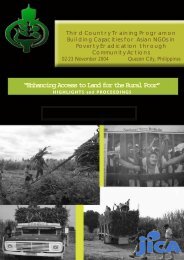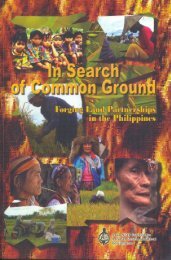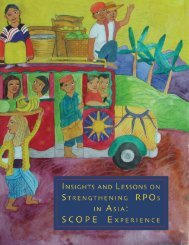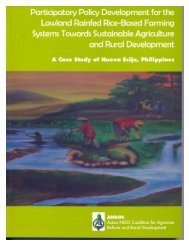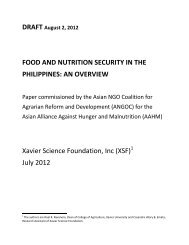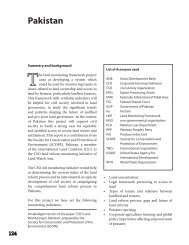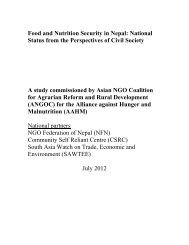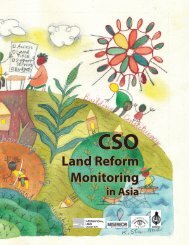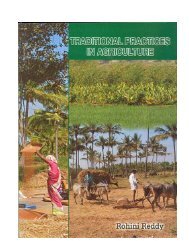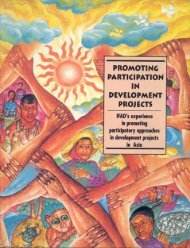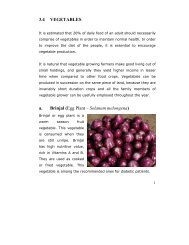Securing the Right to Land FULL - ANGOC
Securing the Right to Land FULL - ANGOC
Securing the Right to Land FULL - ANGOC
Create successful ePaper yourself
Turn your PDF publications into a flip-book with our unique Google optimized e-Paper software.
SECURING THE RIGHT TO LAND148<br />
Forestry<br />
Community Based Forest Management Agreement (CBFMA)<br />
The CBFM Program was instituted by <strong>the</strong> government in 1995.<br />
Its underlying principle is that “equity refers not only <strong>to</strong> <strong>the</strong><br />
sharing of benefits but [also] <strong>the</strong> responsibility of sustainable<br />
development.” Through <strong>the</strong> issuance of CBFMAs, <strong>the</strong> CBFM<br />
program provides land tenure <strong>to</strong> organized upland groups<br />
(POs), and entitles <strong>the</strong>m <strong>to</strong> utilize a designated forest land for<br />
a period of 25 years, renewable for ano<strong>the</strong>r 25 years subject<br />
<strong>to</strong> certain conditions.<br />
Indigenous Peoples<br />
3-Dimensional Mapping of Ancestral Domains<br />
Unlike conventional maps, a 3-dimensional (3-D) map includes<br />
3-D representations of significant natural features (such as<br />
mountains, bodies of water, etc.) as well as sites with social,<br />
cultural and spiritual significance. A 3-D map thus reflects residents’<br />
knowledge and use of a particular area.<br />
Supplemented by Global Positioning Satellite (GPS) technology for<br />
accuracy, a 3-D map was used by <strong>the</strong> Tagbanwa clan in Calamian,<br />
Palawan <strong>to</strong> bolster its application for a CADC over an area which<br />
had been earlier appropriated by <strong>the</strong> local government.<br />
Thus, on 12 June, 1998, six years after <strong>the</strong> Tagbanwas filed<br />
<strong>the</strong>ir claim, and despite strong opposition, DENR approved <strong>the</strong><br />
Tagbanwa’s CADC application covering 22,400 hectares of land<br />
and waters.<br />
Fisheries<br />
Community-Based Marine Protected Areas<br />
NGOs are promoting <strong>the</strong> CBMPA approach within <strong>the</strong> context of<br />
<strong>the</strong> community-based coastal resource management (CBCRM)<br />
strategy already adopted by <strong>the</strong> government. The CBMPA strategy<br />
involves <strong>the</strong> setting up of a fish sanctuary (where absolutely<br />
no fishing is allowed) and a fishing area where <strong>the</strong> small<br />
fisherfolk will have preferential access as well as direct management<br />
responsibility. These CBMPAs are established in cooperation<br />
with local governments. A locally organized committee<br />
or council manages <strong>the</strong> CBMPA (Haribon, 2004).<br />
Lessons from Interventions and Initiatives <strong>to</strong><br />
Promote Access <strong>to</strong> <strong>Land</strong> and Tenurial Security<br />
1. Government is a key fac<strong>to</strong>r in <strong>the</strong> struggle of <strong>the</strong> basic sec-<br />
<strong>to</strong>rs <strong>to</strong> gain access <strong>to</strong> land and tenurial security. LGUs are<br />
particularly important because of <strong>the</strong>ir local presence and<br />
<strong>the</strong>ir regula<strong>to</strong>ry powers over land and natural resources.<br />
2. The issue of land access and tenurial security for <strong>the</strong> basic<br />
sec<strong>to</strong>rs cannot be divorced from <strong>the</strong> country’s mainstream<br />
economic development strategy. This development paradigm<br />
is characterized by subservience <strong>to</strong> <strong>the</strong> demands of globalization<br />
and a strategy of resource extraction as <strong>the</strong> major engine<br />
of economic growth.<br />
3. The demise of <strong>the</strong> Congress for People’s Agrarian Reform<br />
(CPAR) notwithstanding, collaboration (perhaps even unity)<br />
among <strong>the</strong> farming sec<strong>to</strong>r at <strong>the</strong> national level is still possible<br />
as long as this is issue-based and <strong>the</strong> parameters of collaboration<br />
are clear and agreed upon by all parties.<br />
4. Studies indicate a trend <strong>to</strong>ward <strong>the</strong> abandonment, sale, or<br />
mortgaging of CARP awarded lands. The sale of such lands<br />
has been more pronounced in progressive or urbanized areas<br />
where land prices are higher. This phenomenon requires a<br />
careful re-thinking of agrarian reform.<br />
5. Information dissemination and education on land access and<br />
tenurial security rights remain important tasks. Only a small<br />
number of <strong>the</strong> basic sec<strong>to</strong>rs are aware of <strong>the</strong>ir rights.<br />
6. Granting IP communities rights over <strong>the</strong>ir ancestral domain is<br />
highly controversial because <strong>the</strong> latter are richly endowed<br />
with much coveted natural resources. This effort can succeed<br />
only by building a supportive broad, multi-sec<strong>to</strong>ral coalition.<br />
The inclusive <strong>the</strong>me of environmental protection—forest



